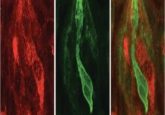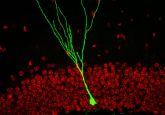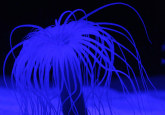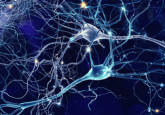The controller of habits
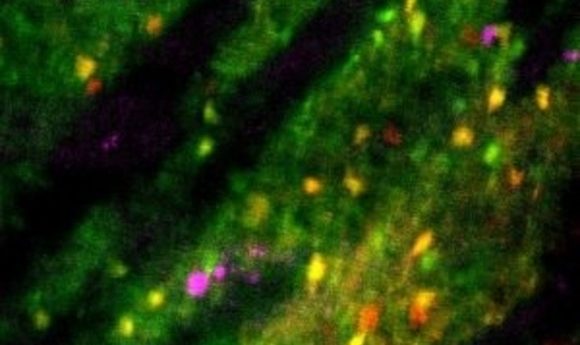
A rare group of cells buried deep in the brain has the power to make or break your habits.
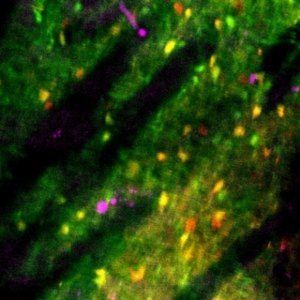
Fast-spiking interneurons, shown here in purple, in the dorsolateral striatum in mice, act as a key signaling conductor controlling habit formation.
Credit: Justin O’Hare, Duke University
Habits play an essential role in our daily lives. From knowing how to hold a pipette to reaching for a midnight snack, they are the brain’s economical solution to performing behaviors without much processing. “It’s that feeling when you wonder, ‘Why did I do that? I wasn’t even hungry. Why did I just grab a cookie as I was walking by?’ You don’t even remember the processing,” said Nicole Calakos from Duke University Medical Center.
Calakos’s team recently identified a rare group of brain cells, called fast-spiking interneurons, that play an essential role in habit formation (1). In an earlier study, the team trained mice to receive a tasty treat by pressing a lever (2). Some of these mice developed a lever pressing habit, where they continued to press the lever even after consuming a large meal and even without receiving a treat.
When the researchers compared the brain activity of these mice to that of mice that did not develop a lever pressing habit, they noticed differences in two neural pathways within the dorsolateral striatum, an area of the brain commonly associated with habits. One pathway stimulated a “go” action response, whereas the other pathway stimulated a “stop” response. In habit-driven mice, the signaling of both pathways increased, but interestingly, the order in which the pathways fired changed. In habit-driven mice, the “go” pathway fired before the “stop” pathway.
The changes seen in both intensity and the order of pathway firing implied that multiple mechanisms were involved in habit formation. Typically, brain plasticity research is conducted by either looking broadly at brain regions or specifically at synapses. However, Calakos’s team employed, for the first time, an intermediate level of analysis that allowed them to explore the whole brain circuit function in its active state, including all of the interneurons and projection neurons as a functional unit and inhibitory and excitatory synapses together.
“The default way of thinking about [habit formation] is that it is likely caused by an excitatory synapse on the main workhorse projection neuron, which would be 95% of neurons in this brain region,” said Calakos. However, because the team visualized the whole circuit, they also saw that a rare cell type, accounting for only 1% of the population, was connected to many other cells.
This rare cell type, called fast-spiking interneurons, relays messages to other neurons. “This is one piece of the puzzle that, if we weren’t looking at the circuit function in the way that we were, then you might have missed it,” said Calakos.
Calakos’s team hypothesized that because of the connectivity of fast-spiking interneurons to many cells, they might be the source of the changes they observed in habit-driven mice. In their new paper, Calakos’s team confirmed their suspicions by looking specifically at the activity of fast-spiking interneurons. They found that these cells were more excitable during habit formation.
When they gave habit-driven mice a drug that decreased the firing of fast-spiking interneurons, the stop and go pathways returned to the order observed in non-habit-driven mice. The stop pathway fired before the go pathway, and the lever pressing behavior disappeared.
According to Kyle Smith from Dartmouth College, who has also studied habit formation but was not involved in these studies, the finding was not completely surprising because previous electrophysiology studies showed that these interneurons participate in habit-like behaviors and may be instrumental to striatum function in general. However, “while there was a precedent for expecting a role for these interneurons in habit formation, it has never been actually shown conclusively,” said Smith.
The exciting element of these papers for Smith was that the interneurons seemed to shape the activity of different populations of projection neurons. “It shows just how important interneurons can be, even in small numbers, for controlling complex behaviors,” said Smith. “We are essentially talking about a major degradation of habits when we disrupt a tiny fraction of cells in just one brain area. It is fascinating how important those cells are!”
Calakos likens the cells to orchestra conductors, where the conductor instructs the musicians to play softer or louder and also dictates which musician plays first.
While these findings shed important light on how the brain develops habits, the results don’t explain everything. One mystery that remains is what cells or processes choose which activities become habitual. According to Calakos, “Whether we’re going to play Bach or Brahms or what piece is going to be played in the habitual manner—that’s one of the big puzzles that we’re faced with now.”

